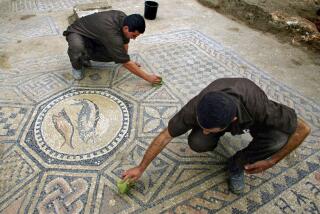Muslim museum is part of Southern landscape
- Share via
JACKSON, MISS. — This mid-sized Southern city, with its thriving Baptist, Methodist and Catholic churches, may seem an unlikely home for one of the only museums in the United States devoted entirely to Muslim culture.
Still, the International Museum of Muslim Cultures opened in April 2001, an attempt by organizers to educate their churchgoing neighbors about a faith that many viewed as mysterious, possibly violent.
The museum is right at home in Jackson’s downtown art district, which continues to host the international ballet competition every four years and, for several years, was home to traveling exhibitions of culture and art treasures from around the world.
Since the Sept. 11 terrorist attacks, museum Executive Director Okolo Rashid said the project in Mississippi had taken on added significance, particularly because many people have serious misconceptions about Muslims and their culture.
The museum was born of an idea to create a companion to the “Majesty of Spain” exhibition -- featuring works from the Prado and other prominent museums -- that was showing at the Mississippi Arts Pavilion, Rashid said.
The Muslim museum opened near the Arts Pavilion with an exhibition titled “Islamic Moorish Spain: Its Legacy to Europe and the West.” Rashid said the response to the show encouraged her and museum board Chairman Emad Al-Turk to keep the museum open past its scheduled closing date at the end of September 2001.
Rabiah Ahmed, communications coordinator for the Washington D.C.-based Council on American-Islamic Relations, said most Muslim exhibitions were relegated to portions of existing museums. She said she knew of no other museum in the United States dedicated entirely to Muslim culture.
“In this day and age, when there are so many misconceptions about Islam, establishing a museum about Islam’s history in America and Muslims in general is another way for Americans to learn about their neighbors and the history of our country,” Ahmed said.
Only one act of violence has occurred at the museum: A brick was thrown into the front window, days after 9/11.
Organizers said the museum’s education objective began to pay dividends as public schools started bringing children to learn more about the culture.
“It was fortunate because it helped create a different image and a dialogue,” Rashid said.
The museum’s current exhibit, “The Legacy of Timbuktu: Wonders of the Written Word,” features handwritten manuscripts, some dating more than 700 years, that help establish the literate culture of Africa.
More to Read
The biggest entertainment stories
Get our big stories about Hollywood, film, television, music, arts, culture and more right in your inbox as soon as they publish.
You may occasionally receive promotional content from the Los Angeles Times.










